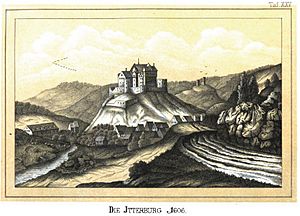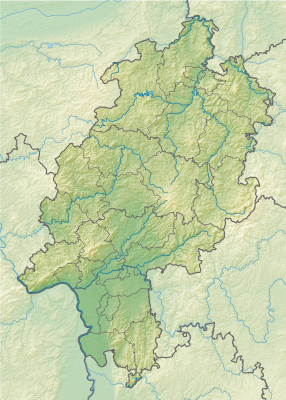Tax Castle (Thalitter)
| Tax castle | ||
|---|---|---|
|
The ruins of the control castle on the right behind the Itterburg around 1606 |
||
| Alternative name (s): | castrum Löwenstein | |
| Castle type : | Hilltop castle | |
| Conservation status: | Wall remains | |
| Standing position : | Local nobility | |
| Construction: | Grauwacke walls | |
| Place: | between Thalitter and Obernburg | |
| Geographical location | 51 ° 13 '34 " N , 8 ° 54' 0" E | |
| Height: | 393 m above sea level NHN | |
|
|
||
The tax Castle is an Outbound hilltop castle in the district Thalitter , in the municipality of Vöhl , in northern Hesse Waldeck-Frankenberg . It is one of the three Itter castles .
location
It is located between Thalitter and Obernburg , about 800 m north-northeast of Thalitter on the Dietrichsberg (393 m above sea level), a few hundred meters east of the federal road 252 from Frankenberg (Eder) to Korbach, which runs in the Itter valley . It can be reached via partially developed forest paths from the district road K 25 in the north or the K 29 in the south.
history
The small castle complex was originally a fore of the Itterburg , which is about 400 m further south-southwest, but was later expanded. Owners were the noble lords of Itter , later half of the lords of Löwenstein, who were associated with them in inheritance , and finally the Gogreve . When the castle was built is not known, nor is it known when it was destroyed. It is mentioned in a document in 1355 when the brothers Heinemann III. and Adolf von Itter, with those of Löwenstein , renewed a truce around Itterburg, the Löwenstein house immediately south of it, and the tax castle.
In 1588 or 1589, Steuerburg von Löwenstein , who later became the commander of the Ziegenhain water fortress , sold the complex with all its accessories to Landgrave Ludwig IV of Hesse-Marburg ; Six years earlier he had inherited the entire Landgrave-Hessian part of the Itter rule from his late brother Philip II of Hesse-Rheinfels and then acquired the remaining (small) remainder of the Itter rule through purchase.
investment
The complex consisted of a strong, brick keep within a courtyard protected by ramparts or walls and moats . It is not known whether other buildings within the courtyard were made of wood or stone. The complex fell into disrepair at the latest in the middle of the 15th century, when Itterburg was abandoned and the new lords of the Itter lordship, Wolff von Gudenberg , moved their residence to Vöhl. As early as the middle of the 19th century, there was only talk of a watch tower , of which only the foundation walls still existed and the surroundings of which were littered with crumbled gray-wacke masonry . During excavations, a vaulted cellar had been found in which there were numerous iron barrel hoops and a table studded with iron.
Notes and individual references
- ↑ He was appointed in 1586 by Landgrave Georg I of Hessen-Darmstadt with Johann von Rolshausen as ambassador to King Heinrich III. sent from France. From 1591 he was in the service of Hessen-Kassel in command of the Kassel fortress , and in 1602 he became a colonel of the Hessian fortress Ziegenhain .
- ↑ Christoph von Rommel: History of Hesse, Volume Five. Perthes, Kassel, 1835 (p. 641)
literature
- CF Günther: Pictures from the Hessian prehistory: With 51 plates illustrations , therein: The Itterburg with the Steuerburg and the Obernburg , Jonghans, Darmstadt, 1853, pp. 334–344
- Rudolf Knappe: Medieval castles in Hessen. 800 castles, castle ruins and fortifications. 3. Edition. Wartberg-Verlag, Gudensberg-Gleichen 2000, ISBN 3-86134-228-6 , p. 151.
Web links
- Tax castle, municipality of Vöhl. Castles, palaces, mansions. In: Landesgeschichtliches Informationssystem Hessen (LAGIS).



